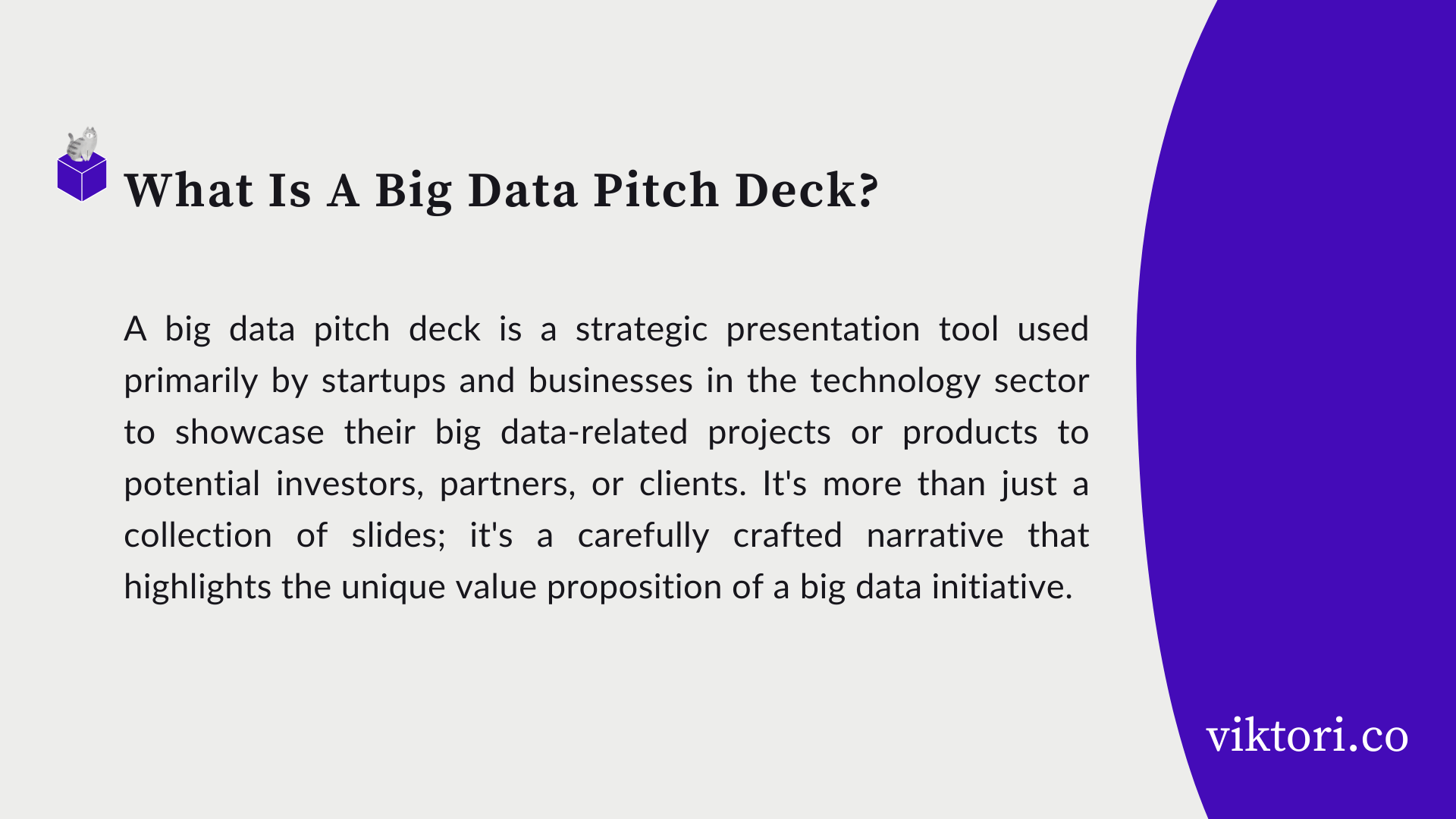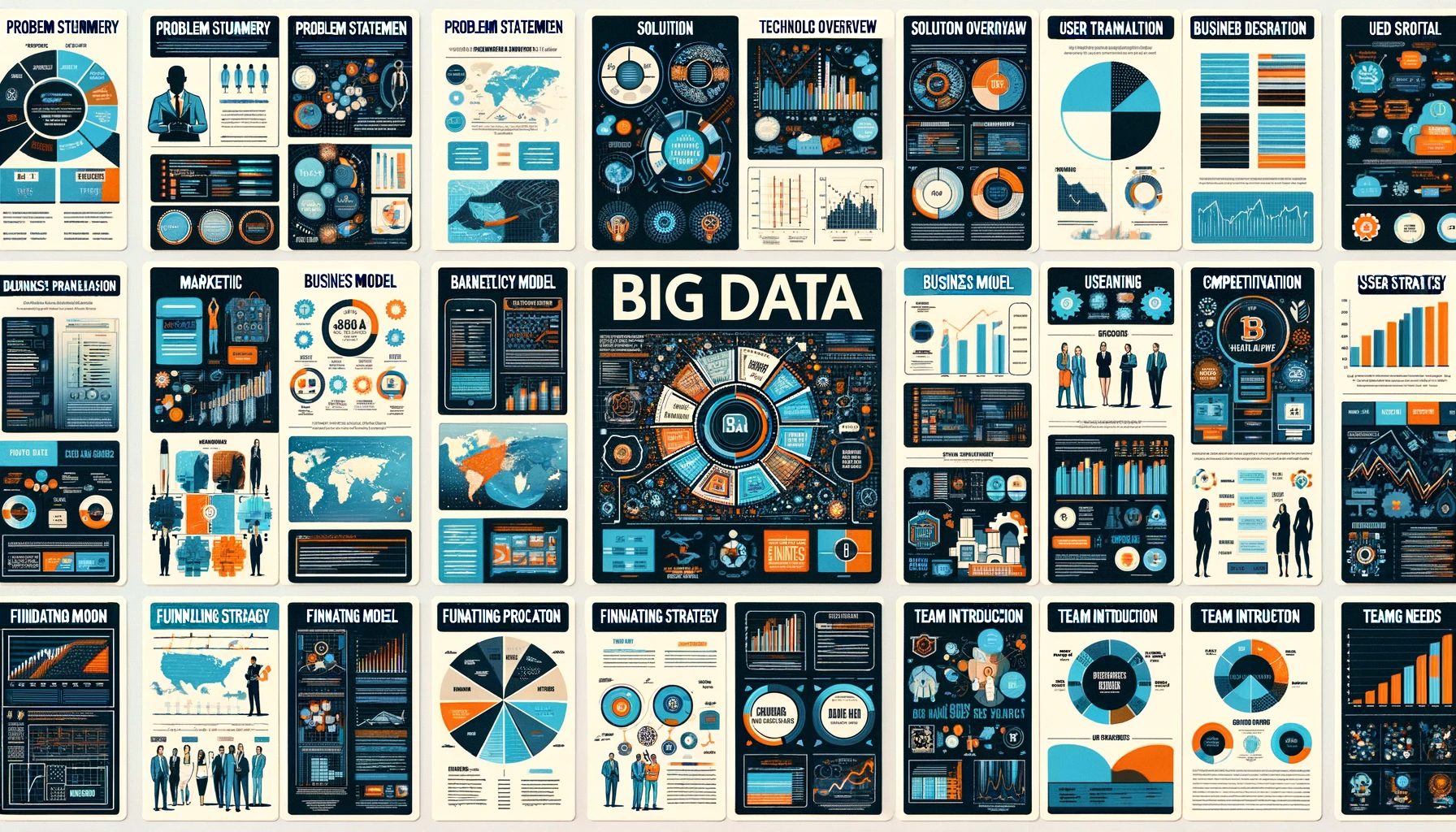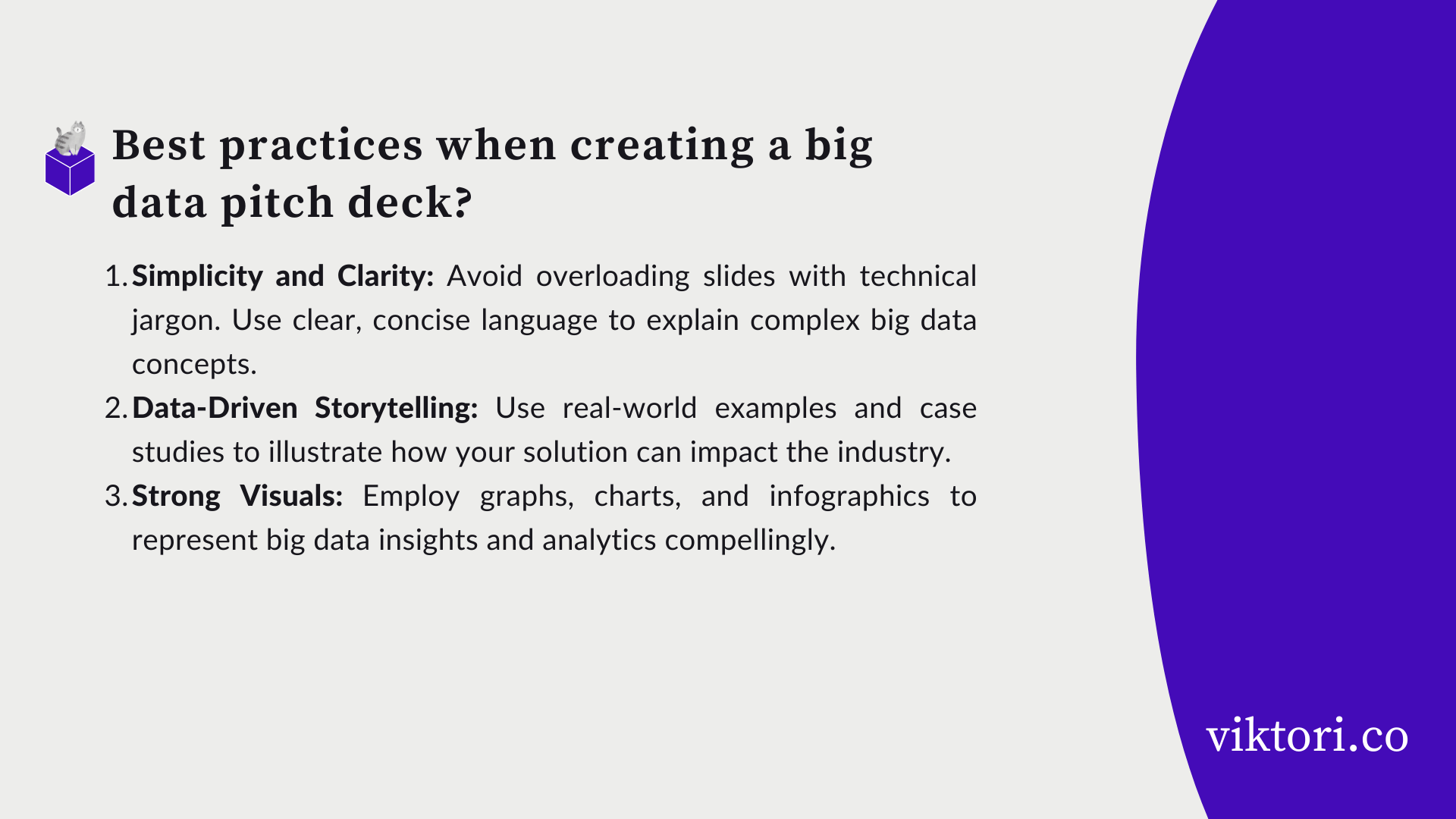In an era where data is the new gold, mastering the art of a big data pitch deck is crucial for any startup or enterprise seeking investment or partnerships. This guide will help you do that.
Whether you’re a startup or a seasoned enterprise, understanding how to effectively communicate the value of your big data project is pivotal.
I’m Viktor, a pitch deck expert, and a presentation expert. Over the past 13 years, I’ve helped businesses secure millions of $ in funding thanks to my approach and I’m sharing it here in this pitch deck guide.
Ok, let’s see what a big data pitch deck actually entails and why it’s a game-changer in the tech industry.
Book a free personalized pitch deck consultation and save over 20 hours of your time.
Join hundreds of successful entrepreneurs who’ve transformed their pitch decks with my help.
Let me develop an investor ready deck by using my hands-off approach, which includes: market research, copy, design, financials, narrative and strategy.
One week turnaround time.
The least you will get is 10 actionable tips & strategies to own that next presentation, worth $599, for free.

- What is a Big Data Pitch Deck?
- What Does A Big Data Pitch Deck Include?
- How to Create a Big Data Pitch Deck Presentation?
- The Exact Big Data Pitch Deck Slide Structure You Can Steal And Use
- Get Your Copy Of My Pitch Deck Template That Helped Clients Get Millions of $ + In Funding
- 4 reasons why is it important to understand your audience when creating a big data pitch deck
- 4 Specific reasons why you need to craft a story in your big data pitch deck
- How important are design and visuals when creating a big data pitch deck?
- How to prepare for questions and objections when presenting a big data pitch deck?
- What are the best practices when creating a big data pitch deck?
- Big Data Startup Examples
- How Much Did They Raise?
- Example Pitch Decks Slide Outlines
- Questions That Investors Ask Big Data Pitch Deck Owners
- Big Data Startup Pitch Deck Guide: Conclusion
- More Resource
What is a Big Data Pitch Deck?

A big data pitch deck is a strategic presentation tool used primarily by startups and businesses in the technology sector to showcase their big data-related projects or products to potential investors, partners, or clients. It’s more than just a collection of slides; it’s a carefully crafted narrative that highlights the unique value proposition of a big data initiative.
In essence, the pitch deck serves as a bridge, connecting the complex and often technical aspects of big data with the practical needs and interests of the audience.
It must effectively communicate how the company’s use of big data analytics, algorithms, and data processing techniques can solve real-world problems, generate new insights, or create market opportunities.
What Does A Big Data Pitch Deck Include?
Here are the most important parts:
- Executive Summary: A concise overview of the business idea and its relevance in the big data industry.
- Problem Statement: Clearly define the specific problem or opportunity in the big data realm that the startup intends to address.
- Solution: Detail how the product or service uses big data analytics, machine learning, or related technologies to solve the identified problem.
- Technology Overview: Explain the underlying technology, data processing techniques, and innovative approaches used.
- Market Analysis: Present data-driven insights into market size, growth potential, and target audience specific to the big data sector.
- Business Model: Describe how the startup plans to generate revenue, focusing on big data monetization strategies.
- Competitive Analysis: Analyze competitors in the big data space, highlighting your startup’s unique edge.
- User Testimonials and Case Studies: Share real-world examples or pilot studies demonstrating the effectiveness of your big data solution.
- Go-to-Market Strategy: Outline the plan for market entry and growth, specifically within the big data industry.
- Financial Projections: Provide realistic financial forecasts, emphasizing the scalability of big data solutions.
- The Team: Showcase the team’s expertise in big data, analytics, and industry knowledge.
- Funding Requirements: Clearly state the funding needed and how it will be utilized, particularly in advancing big data capabilities.
- Future Roadmap: Outline future plans for expansion or development in the big data field.
How to Create a Big Data Pitch Deck Presentation?
Creating a big data pitch deck presentation tailored to the industry involves several strategic steps:
- Understand Your Audience: Identify whether you’re addressing venture capitalists, angel investors, or industry partners. Tailor your content to their interests, especially focusing on how big data drives innovation and profitability in your sector.
- Convey the Big Data Story: Start with a compelling narrative about the power of big data in transforming industries. Use real-world examples to illustrate the impact of data analytics and insights.
- Highlight Technical Expertise: Emphasize your team’s expertise in data science, analytics, and industry-specific knowledge. Show how this expertise translates into a competitive advantage.
- Showcase the Solution: Clearly articulate how your product or service leverages big data to solve a significant industry problem. Include demonstrations or case studies to support your claims.
- Market Analysis and Potential: Provide a detailed analysis of the big data market within your industry. Highlight the growth potential, target market, and how your solution fits into this landscape.
- Visualize Data and Insights: Use infographics, charts, and visuals to represent complex data points and analytics clearly and compellingly.
- Financials and Projections: Present well-researched financial projections, focusing on how big data will drive revenue and growth in your specific industry context.
- Interactivity and Engagement: Make your pitch interactive, possibly including live demos or interactive data visualizations to engage your audience more deeply.
- Practice and Refine: Rehearse your presentation to ensure clarity and confidence. Be prepared to answer industry-specific questions about big data applications and potential challenges.
The Exact Big Data Pitch Deck Slide Structure You Can Steal And Use

The structure of a big data pitch deck can be pivotal in delivering your message effectively. Here’s a slide-by-slide breakdown that you can use as a template:
- Title Slide: Company name, logo, and brief tagline or motto.
- Executive Summary: A snapshot of your business proposition.
- Problem Statement: Address the industry-specific challenge or opportunity.
- Solution: How your product/service uses big data to address the problem.
- Technology Overview: Dive into the big data technologies employed.
- Market Analysis: Size, trends, and potential of the big data market in your industry.
- Business Model: How you plan to make money from your big data solution.
- Competitive Analysis: Positioning against other big data players in the market.
- User Testimonials/Case Studies: Real-world success stories or pilot results.
- Marketing and Sales Strategy: How you plan to attract and retain customers.
- Financial Projections: Key financial metrics and future projections.
- The Team: Introduce the brains behind the project, emphasizing big data expertise.
- Funding Needs: Specify the investment you’re seeking and its allocation.
- Closing Slide: A compelling end note, contact information, and call to action.
Remember, while the content is important, how it’s presented matters equally. Engaging visuals, clear data representations, and a coherent narrative flow are essential.
Check out my detailed big data pitch deck outline guide for more info.
Get Your Copy Of My Pitch Deck Template That Helped Clients Get Millions of $ + In Funding
To grab the attention of buyers and investors when pitching a data-related product or service, a precise and comprehensive pitch deck is essential.
The good news is that creating an effective deck is all about selecting the right slides to include, and there are multiple templates available on sites like Canva and Google Slides.
However, these pre-made templates may not align with the brand you represent, which means you’ll have to spend a significant amount of time adjusting them to fit your brand guidelines.
Fortunately, there’s a better way. By using a custom-written template, you can save time and design a deck that aligns with your brand identity. My clients have used this approach to develop a stellar pitch decks in half the time and secure funding, deals, and investments worth millions. If you’re looking for a streamlined approach to creating a pitch deck for your data-related business, get in touch to access the winning template that has helped others achieve success.
4 reasons why is it important to understand your audience when creating a big data pitch deck
Understanding your audience is crucial when creating a big data pitch deck because of few things:
- Tailored Messaging: Different audiences have varied interests and levels of understanding. For instance, technical details might be essential for a tech-savvy investor but overwhelming for someone with a more general business background. Tailoring the pitch to your audience’s level of expertise ensures effective communication.
- Highlighting Relevant Benefits: Knowing your audience allows you to emphasize aspects of your big data project that are most relevant to them, whether it’s the technological innovation, market potential, financial returns, or societal impact.
- Building Credibility and Trust: Demonstrating awareness of the audience’s needs and expectations can establish credibility and foster trust, which are key in convincing investors or partners to support your project.
- Effective Problem-Solution Fit: Understanding your audience helps in clearly articulating how your big data solution addresses a problem or opportunity they care about.
Next, we will discuss the importance of crafting a compelling story in your big data pitch deck, especially how it resonates within the industry.
4 Specific reasons why you need to craft a story in your big data pitch deck
Crafting a compelling story in a big data pitch deck is vital for several reasons.
- Engaging the Audience: A story captivates and keeps the audience engaged, making the pitch more memorable. In the context of big data, this means translating complex data and analytics into relatable narratives.
- Simplifying Complex Concepts: Big data can be intricate and technical. A good story simplifies these complexities, making the concepts more accessible and understandable to the audience, regardless of their technical background.
- Emotional Connection: Stories can evoke emotions and build a personal connection, making the pitch more impactful. In the big data realm, this could involve showing how the data can improve lives or transform businesses.
- Clarifying the Vision: A well-crafted story articulates the vision and mission of the big data project, helping the audience see the larger picture and the long-term impact of the initiative.
To help you improve your narrative, check this selection on the best books for pitching. The authors have won billions in $ thanks to their ability to create stories when pitching and are sharing their methods with you.
Next, we will explore how design and visuals play a crucial role in enhancing a big data pitch deck, particularly in the industry context.
How important are design and visuals when creating a big data pitch deck?
Design and visuals are critically important in a big data pitch deck, and here’s why.
- Clarifying Complex Data: Big data inherently involves complex sets of information. Effective visuals can distill this complexity into understandable and engaging formats, making it easier for the audience to grasp key insights.
- Professionalism and Credibility: High-quality design reflects professionalism and credibility, vital in industries where big data plays a crucial role, like finance, healthcare, or retail.
- Engagement and Retention: Well-designed visuals keep the audience engaged, aiding in better retention of the presented information.
- Demonstrating Technical Proficiency: In the big data industry, sophisticated and sleek visuals can showcase your technical proficiency and attention to detail, which is essential for stakeholders.
Hold on. You might want to check my list on the best presentation books. Why?
It’s 1O crucial books that will help you improve the design and structure of your presentations, besides improving its delivery. Check it out below.

Next, we will discuss strategies to prepare for questions and objections when presenting a big data pitch deck, specifically tailored to industry needs.
How to prepare for questions and objections when presenting a big data pitch deck?
Preparing for questions and objections when presenting a big data pitch deck in the industry involves:
- Anticipate Common Questions: Based on your industry, anticipate questions related to data security, compliance, scalability, and ROI of big data projects.
- Understand Industry Concerns: Be well-versed with industry-specific challenges and trends. For example, in healthcare, be prepared to address questions about patient data privacy.
- Data and Case Studies: Have data and case studies ready to substantiate your claims, especially about the effectiveness and efficiency of your big data solution.
- Rehearse Responses: Practice answering tough questions to ensure confidence and coherence in your responses.
- Feedback Loop: Be open to feedback and ready to discuss potential modifications or iterations to your big data solution based on investor or client input.
Next, let’s look at creating an image depicting a big data pitch deck startup owner answering questions in front of a panel of investors.
What are the best practices when creating a big data pitch deck?

Best practices for creating a big data pitch deck, tailored for the industry, include:
- Simplicity and Clarity: Avoid overloading slides with technical jargon. Use clear, concise language to explain complex big data concepts.
- Data-Driven Storytelling: Use real-world examples and case studies to illustrate how your solution can impact the industry.
- Strong Visuals: Employ graphs, charts, and infographics to represent big data insights and analytics compellingly.
- Focus on Value Proposition: Clearly articulate how your big data solution addresses specific industry needs and creates value.
- Credibility and Trust: Highlight qualifications, experiences, and past successes of your team in big data.
- Customization for Audience: Tailor the pitch deck to the interests and expertise level of your audience, whether they are industry experts, venture capitalists, or potential partners.
Next, we will explore big data pitch deck examples and their success metrics.
Big Data Startup Examples
Here are examples of successful big data pitch decks from various startups:
- Apptopia: Serving the mobile industry with services like app analytics and data mining, Apptopia operates on a B2B subscription business model. In 2018, their Series A pitch deck helped them raise $1.46 million.
- Cloudian: Cloudian provides object storage for enterprise customers, using a SaaS business model. Their 2018 late-stage pitch deck secured $94 million in funding.
- Cloudera: Specializing in data management software for enterprises, Cloudera’s SaaS model was presented in their 2008 Series A pitch deck, resulting in a $5 million funding.
- Crunchbase: Known for its platform for discovering business information, Crunchbase operates on a marketplace model and raised $30 million in their 2019 late-stage pitch deck.
- Foursquare: A location-based technology company providing business insights and consumer tips, Foursquare raised $1.4 million in their 2009 Series A round, operating with an app-based B2B model.
These examples highlight the diversity in business models, customer bases, and the amounts raised, showcasing the wide-ranging applications and potential of big data in various sectors.
How Much Did They Raise?
| Startup | Niche/Area of Focus | Amount Raised |
|---|---|---|
| Apptopia | Mobile industry services (app analytics, data mining) | $1.46M |
| Cloudian | Enterprise object storage (SaaS) | $94M |
| Cloudera | Data management software for enterprises | $5M |
| Crunchbase | Business information discovery platform | $30M |
| Foursquare | Location-based insights for businesses and consumers | $1.4M |
These startups span various aspects of big data application, from analytics and data mining to data management and location-based services, reflecting the dynamic range of opportunities within the big data section you visualize a successful big data sector.
Example Pitch Decks Slide Outlines
Here are some hypothetical examples of big data pitch decks based on various business ideas:
- Healthcare Data Analytics Startup:
- Slide 1: Introduction to healthcare data challenges.
- Slide 2: Solution – Advanced analytics for patient data.
- Slide 3: Market size and potential in healthcare analytics.
- Slide 4: Technology – AI-driven data processing tools.
- Slide 5: Business model – Subscription-based analytics service.
- Retail Consumer Behavior Analysis Firm:
- Slide 1: Overview of retail market dynamics.
- Slide 2: Solution – Big data insights into consumer behavior.
- Slide 3: Competitive analysis in retail analytics.
- Slide 4: Data visualization capabilities for retailers.
- Slide 5: Revenue model – Custom analytics packages.
- Supply Chain Optimization Company:
- Slide 1: Introduction to supply chain complexities.
- Slide 2: Big data solution for logistics optimization.
- Slide 3: Market opportunities in supply chain management.
- Slide 4: Technology stack – IoT and big data integration.
- Slide 5: Business model – Performance-based pricing.
These hypothetical pitch decks illustrate how different big data applications can be presented, each tailored to specific industry needs and opportunities. Check out the fully fleshed out big data pitch examples here.
Questions That Investors Ask Big Data Pitch Deck Owners

Investors typically ask big data pitch deck owners a range of industry-specific questions:
- Data Sourcing and Integrity: “How do you source your data, and how do you ensure its accuracy and integrity?”
- Privacy and Compliance: “What measures do you take to ensure data privacy and regulatory compliance, especially in industries like healthcare or finance?”
- Scalability: “How scalable is your big data solution as the volume of data grows?”
- Differentiation: “What sets your big data solution apart from existing solutions in the market?”
- Monetization Strategy: “How do you plan to monetize your big data insights, and what is the projected ROI?”
- Technical Challenges: “What are the major technical challenges you anticipate, and how are you equipped to handle them?”
- Customer Acquisition: “What is your strategy for acquiring and retaining customers in your specific industry?”
These questions focus on critical aspects of big data ventures, from technical capabilities and compliance to market strategy and financial projections.
Big Data Startup Pitch Deck Guide: Conclusion
In conclusion, crafting a successful big data pitch deck is an intricate blend of clarity, storytelling, and technical insight. It requires not just an understanding of big data analytics, but also a keen sense of how to communicate its value to a specific audience.
From the importance of a well-structured story to the impact of compelling visuals and the necessity of anticipating investor queries, each element plays a crucial role. The big data landscape offers vast opportunities, and a well-prepared pitch deck is your key to unlocking these.
Whether you’re a startup or an established player, mastering the art of the big data pitch deck is essential for securing funding, forging partnerships, and driving innovation in this dynamic field. You got this.
But if you don’t got it:
Join hundreds of successful entrepreneurs who’ve transformed their pitch decks with my help.
Let me develop an investor ready deck by using my hands-off approach, which includes: market research, copy, design, financials, narrative and strategy.
One week turnaround time.
The least you will get is 10 actionable tips & strategies to own that next presentation, worth $599, for free.

More Resource
Check my cornerstone guide on pitch decks that helped my clients win millions of $ in funding:
You’ll learn how to create a pitch deck by following my bulletproof step-by-step guide that helped my clients get $100+mill in funding. It includes:
- How to build the slides (including elevator pitch slide, financials slide, and more)
- Startup pitch deck examples
- What investors need to see
- What a pitch deck needs to be
- What a pitch deck can’t be
- Tips and tricks when creating a pitch presentation
If you want to really dive into the world of pitch decks, check out our complete collection of pitch deck guides, pitch deck outlines and pitch deck examples.
Check out a selection of other pitch deck guides here:
Also don’t miss out on my massive presentation specialist guide, last minute presentations and best business projector buyers guide.

